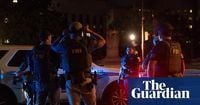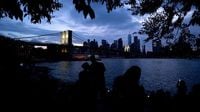It’s been a tumultuous August in America’s largest cities, with Washington, D.C. and New York City at the epicenter of a dramatic tug-of-war over federal power, local autonomy, and the livelihoods of millions. President Donald Trump’s aggressive interventions—ranging from direct control of police departments to sweeping budget cuts and immigration crackdowns—have ignited legal battles, public protests, and deep anxiety among city leaders and residents alike.
On August 15, 2025, the Trump administration made an abrupt about-face regarding Washington, D.C.’s police department. After days of escalating intervention, including the appointment of a federal official as the emergency head of the Metropolitan Police Department, the administration agreed to leave Chief Pamela Smith in control—at least for now. But the partial retreat was hardly a full concession. Attorney General Pam Bondi, in a newly issued memo, directed the District’s police to cooperate with federal immigration enforcement, regardless of any city law that might say otherwise. The move came just hours after D.C. officials filed a lawsuit to block President Trump’s attempted takeover of the city’s police force, marking a historic—and deeply controversial—assertion of federal authority over a local government.
"In my nearly three decades in law enforcement, I have never seen a single government action that would cause a greater threat to law and order than this dangerous directive," Chief Smith declared in a court filing, according to the Associated Press. Her warning underscored the deep sense of alarm felt by many in the capital, where the sight of National Guard troops and federal law enforcement teams patrolling the streets has become a daily reality. By Friday, more than 1,750 federal personnel had been deployed, making 33 arrests—including 15 migrants without permanent legal status and others wanted for serious crimes.
The legal wrangling reached a fever pitch on August 15, when U.S. District Judge Ana Reyes, overseeing the lawsuit, signaled skepticism about the administration’s authority. "The way I read the statute, the president can ask, the mayor must provide, but the president can't control," Reyes said, suggesting the law grants the president more power than the city might like, but not carte blanche to seize control. The Home Rule Act, passed in 1973, limits presidential control of D.C.’s police to 30 days without congressional approval—a safeguard Trump has openly suggested he might seek to bypass.
Attorney General Bondi’s directive to install Drug Enforcement Administration chief Terry Cole as police head came after Chief Smith had instructed her officers to share information with immigration agencies only in non-custodial encounters, such as traffic stops. Bondi argued that Smith’s guidance amounted to a continuation of "sanctuary policies" that limit cooperation with federal immigration officers. The Justice Department, meanwhile, insisted that the president has broad authority to determine what kind of help the city’s police must provide.
The consequences of these policies have been immediate and tangible. Immigrant advocates in Washington, like Anusce Sanai of Ayuda, are now rethinking the advice they give to clients. "Even with the most anti-immigrant administration, we would always tell our clients that they must call the police, that they should call the police," Sanai explained. "But now we find ourselves that we have to be very careful on what we advise." Amy Fischer, an organizer with Migrant Solidarity Mutual Aid, described a "really significant change" in ICE activity, with federal officers conducting roving patrols and hotlines for reporting ICE activity ringing off the hook.
The unrest in Washington is mirrored by growing unease in New York City, where President Trump’s threats to seize control have stoked fears of a similar federal intervention. "I’m going to look at New York in a little while," Trump said on August 11, just days after his dramatic moves in the capital. The specter of federal troops in Manhattan or Brooklyn is only the tip of the iceberg, however. According to CNN, it’s Trump’s economic and immigration policies that pose the most serious threat to the city’s future.
Despite a remarkable recovery from the COVID-19 pandemic—with the city boasting roughly 200,000 more jobs than before the crisis—New York’s growth is now sputtering. In the first half of 2025, businesses added a net 956 private-sector jobs, the slowest pace outside a recession in decades. International tourism is expected to plummet by 17% this year, with two million fewer travelers—mainly Canadians—opting to stay home after Trump’s threats to annex Canada sent shockwaves across the border.
The city’s immigrant workforce, a vital engine of its economy, is also under siege. New York State is home to about 670,000 undocumented immigrants, 80% of whom work in food service, construction, and home health care. Since the third quarter of 2024, labor force participation among Hispanic men in New York City has dropped 3.6 percentage points—the largest decline of any demographic group. Trump’s deportation push, business leaders warn, is eroding the city’s "competitive advantage" as a magnet for global talent, while also threatening the fabric of entire communities.
Adding to the city’s woes is the One Big Beautiful Bill Act, enacted in July 2025. State officials and budget experts say the new law will result in 1.5 million New Yorkers losing health insurance, 300,000 households seeing their SNAP benefits slashed, $13 billion in health care cuts with 200,000 job losses, and higher long-term energy costs due to the elimination of clean energy projects. New York State now faces a $34 billion budget deficit—the largest since the 2008 financial crisis—thanks to federal spending cuts and a weakening economy. "Prospectively, federal budget cuts are the most serious threat to the city," said Kathryn Wylde, leader of the Partnership for New York City.
Meanwhile, the political landscape is shifting. Zohran Mamdani, the democratic socialist who won New York City’s Democratic mayoral primary in June, has promised sweeping reforms: rent freezes, free public buses, universal child care, and massive investments in affordable housing. Trump, for his part, has threatened to use federal power to seize control if Mamdani becomes mayor, and his administration has already sued to block the city’s congestion pricing program—threatening to choke off vital transit funding.
Business leaders are divided. Some, like Bill Ackman and John Catsimatidis, have praised Trump’s tax and deregulation policies. Others, like City Comptroller Brad Lander, worry that Trump’s economic agenda—particularly his tariffs and budget cuts—poses "very real risks to the global economy and cities that are closely tied into it—New York City, first and foremost." Lander also notes that the precarious fiscal landscape may make it tougher for Mamdani to deliver on his promises: "Money that is needed to address cuts to Medicaid or SNAP or housing assistance is money that you can’t use to expand childcare or free buses or affordable housing."
Back in Washington, D.C., the legal fight rages on, and the city’s residents remain anxious. More than 100 protesters gathered outside police headquarters on August 15, chanting "Protect home rule!" and waving signs that read "Resist!" The outcome of these battles will shape not only the fate of two iconic cities, but the balance of power between federal and local governments for years to come.
As summer winds down, the nation’s capital and its largest metropolis stand at a crossroads, their futures hanging in the balance as the struggle over who holds the reins of power continues to play out on the streets, in the courts, and in the halls of government.


